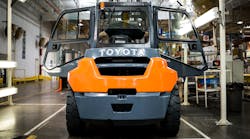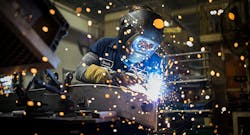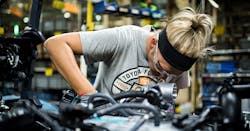Nibbling at the Edges: Toyota Material Handling's Plan for IoT Success
Alan Cseresznyak is thinking big.
As chief information officer and senior vice president of Toyota Material Handling, North America, Cseresznyak is at the digital helm of the region's dominant forklift and lift truck producer. With three plants and 8,400 workers in the U.S. manufacturing and distributing both Toyota and Raymond brand equipment, the company has the North American market just about cornered—according to Cseresznyak, about one in every three forklifts sold here is made in his plants.
That's a fine position to be in today. But Cseresznyak is far more concerned with tomorrow. Specifically, he's concerned with the tomorrow of IoT and connected machines.
"We're looking at new ways we can serve our customers, reduce downtime, and improve customer satisfaction and customer experience," he explains. To do this, he adds, "we have several IoT initiatives—we are developing our next generation telematics, we're investigating different artificial intelligence and predictive analytics toolsets. We see the potential to expand into areas of smart factory and Industry 4.0 compliance."
It's a plan, he says, that will eventually connect every truck his company produces into an elaborate web of real-time data and analytics designed to keep them running at 100% health and capacity whenever they are needed.
It's an ambitious plan, but also a familiar story in the industry today.
According to a recent Forrester report, 67% of manufacturers will be exploring IoT initiatives for their plants and operations within the next year. But for many companies (84%, according to McKinsey & Co.), these projects remain stuck in that exploration stage, never fully translating those big thoughts into reality.
It's easy to understand why. Overhauling a company of any size for the IoT future is no easy endeavor. From the outside, it can appear extremely costly, difficult and technical, filled with endless needs for new hardware and software, for new skills and processes, and new strategies to pull it all together.
In this respect, Toyota Material Handling—despite its size and resources—is in the same boat as the rest of the industry.
"We're not really strong in the data scientist area," Cseresznyak admits. Like other manufacturers with operations predating the IoT, Toyota Material Handling is staffed for world-class production, not state-of-the-art analytics. Which means, despite Cseresznyak's big ideas, the company could easily get stuck in that same restaffing/retooling IoT quagmire as so many others.
But it has not.
This is what makes Toyota Material Handling's digital transformation exceptional—where other IoT strategies depend on big investments and big overhauls, TMH has taken a much smaller approach.
In the process, the company defines a working plan for IoT implementation that can form the basis for digital transformation strategies across the industry. Its premise is simple: Keep it simple.
Big Plans, Small Steps
While Cseresznyak's end game seems to be nothing less than the total digital reconstruction of the company, its fleet, and its operations, today its greatest IoT breakthrough is running on just a single line of welding machines in its Columbus, Indiana, plant.
The welding experiment began with a partnership with an operational machine learning system called Falkonry LRS. According to Crick Waters, senior vice president of customer success for the Sunnyvale, California-based company, the software is the kind of streamlined AI that non-data-science-rich manufacturers seem to crave.
"The Falkonry software identifies patterns over time," Waters explains. "Then it provides insights back to the user based on the patterns it sees."
Simple enough.
As a proof of concept, Cseresznyak brought Falkonry LRS into the Columbus plant to test its metal in the real world.
"We analyzed 62,000 welds in about two and half minutes," Cseresznyak recalls. "Then our engineers were able to look at the different classifications that Falkonry identified and identify which welds were superior, which were good, which were normal and which were poor."
Based on that simple data set, the system was able to learn directly from the engineers how to identify good welds and begin scanning and analyzing results in real time.
It didn't take long to find the payoff.
"We were able to identify one machine that was consistently performing at the poor level," Cseresznyak says. "We took corrective action to bring that particular machine up to satisfactory level."
There's an easy win for AI right out of the gates: one simple program, one simple process, and the plant is already producing better products. So far, so good.
Strategy for Success
While this is a good start on the process, it's an awfully big jump to go from a few welders to a full fleet of smart, connected and optimized equipment. And that's the point, really—building the digital factory isn't an overnight process; it's a journey.
"The exciting and scary thing about the IoT is that is isn't a single technology, but a combination of technologies," explains author and consultant W. David Stephenson. "It's a moving target."
A successful IoT strategy, Stephenson argues, takes this fact firmly into account. It also validates Toyota's plan here.
Rather than developing massive, "boil the ocean" digital strategies, he says, companies should concentrate on "nibbling at the edges, particularly on the maintenance and operations side of things."
Doing this, he explains, provides "a kind of microcosm of the whole IoT—you get an inkling of what it would be like and allows you to gain a little comfort level with it, while collecting some tangible results."
This is the first step to successful IoT implementation—testing the waters, so to speak, to get a feel for the power and potential of the technology.
From there, Stephenson outlines something that has been critically lacking in most of the IoT conversations to date: a clear, three-part plan to take those early implementation tests into a full-scale IoT strategy.
Step One: Ask New Questions
The first, and possibly most difficult, step in this process is a bit of mental yoga—stretching your creativity to ask new questions about old processes.
To help with this, Stephenson has developed a thought model designed to get the ingenuity flowing.
"Before the IoT, we were suffering from the terrible condition of collective blindness—a condition that affected every single human being on the planet without exception," Davison explains. "It manifested itself by the fact that we couldn't see (literally and figuratively) inside of things to see if they were working or not.
"Now with the IoT, we can lift that collective blindness."
In this model, the first new question most companies should be asking is, "How can we design our products and processes so we can get rid of that collective blindness and see, for the first time, how things are really working?" Stephenson suggests.
It's a question, he says, guaranteed to provide "years of opportunity to think of new ways of doing stuff."
At Toyota Material Handling, Cseresznyak certainly seems to have this step down.
Beyond the welding experiment, one of the primary goals in this IoT strategy is to eliminate his blindness in the health and wellness of his fleet. Specifically, he wants to stop breakdowns before they occur.
The problem, though, is that the current maintenance model only provides condition data after the breakdown.
"It's mostly after the fact," Cseresznyak explains. "We analyze why something broke down and take corrective action, but we really aren't predicting breakdowns based on external information. It's really more of known issues that were reported by either the customer or the dealer network."
In other words, the company has been blind to operating conditions everywhere between sales and repair. Cseresznyak's IoT plan is centered around correcting this.
"Now, we're putting more sensors into our vehicles and working with Microsoft to develop a next-generation telematics system," Cseresznyak explains. "With this, we can better predict what types of vehicles will break down and take corrective actions before they go down so we can increase customer uptime."
Step Two: Empower Your Workers
Of the many "fundamental shifts" that go into a digital transformation, one of the most critical is the role experienced workers play in the process.
Stephenson characterizes this by a shift in the flow of data.
"One of the essential truths of IoT is, 'share data, don't hoard it,'" he says. "For so long, it was hard to get data and especially hard to distribute it, so it made sense to have senior management control the flow, rather than those on the front lines who could actually use it."
Today, with the easy abundance of data the IoT creates, this model no longer makes sense.
"It's the people on the front lines who have the ideas on how to improve quality and productivity," Stephenson argues. The IoT presents the opportunity to empower those experienced workers to help drive the opportunities the technology provides.
Here, too, TMH is a leading example.
The system Cseresznyak employed for its early work in machine learning, Falkonry LRS, is part of a new breed of software that is custom-suited for the industry. Rather than the traditional, complex systems that require months of implementation—plus teams of specialists, data scientists and software engineers to control—these packages require only the input of the plant experts who know the business best.
"Falkonry is designed for process or maintenance engineering managers," Falkonry's Waters explains. "These are individuals who have domain expertise and understand the operation of the factory or facility, but potentially have absolutely no knowledge at all about data science or numeric modeling."
And that is exactly how it played out at the Columbus, Indiana, plant.
After the program was remotely installed on the welding system, the software captured all the data it needed on their performance. But it was Toyota Material Handling's manufacturing experts, not software engineers or data scientists, who taught the system what the data meant.
Step Three: Define Your Business Case
The final ingredient to this—though it can be said of any strategy, really—is a strong business case for investment.
The IoT is very hip right now, and any project involving AI or machine learning or telematics probably looks great on an investor report. But without a real and tangible objective, such endeavors are bound to fizzle out.
Here, above all, Toyota Material Handling really shines.
Cseresznyak understands the one fundamental truth from his customers: Reliability trumps all.
"The most important value for our customers is uptime," he explains. "That's even more so than the cost of the forklift itself."
This appears to be the defining principle of Toyota Material Handling's entire IoT strategy.
"Really, it's all about quality; it's all about reliability and superior access to service," Cseresznyak says. "Anything we can do to improve the quality of our products is a value to Toyota, and we can use skillsets like artificial intelligence and predictive analytics to provide better customer service and better customer experience."
With these three steps in place, the future for Toyota Material Handling seems wide open.
"We're not sure where we'll stop with this," Cseresznyak notes. "We're just dipping our toes in the water right now; we have a long way to go."
The general scope of this process is fairly well-defined for now, though. Cseresznyak knows his forklifts will need new sensors and a new software system to support the information those sensors collect even before they can begin testing their telematics service.
But that heavy work ahead doesn't seem to bother him. It's all part of the journey. The most important thing now is just to keep moving.
"I don't think you want to sit back and wait for things to happen," he says. "I think you want to be a leader in this area; you want to utilize technology that gives you a competitive advantage."






